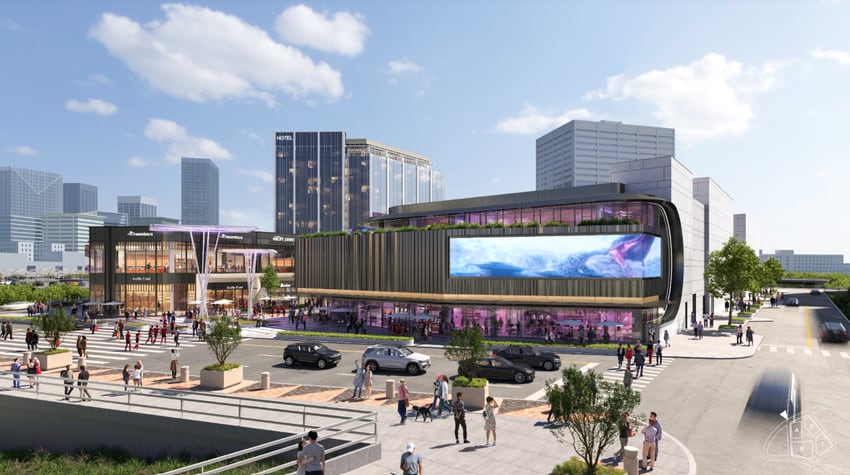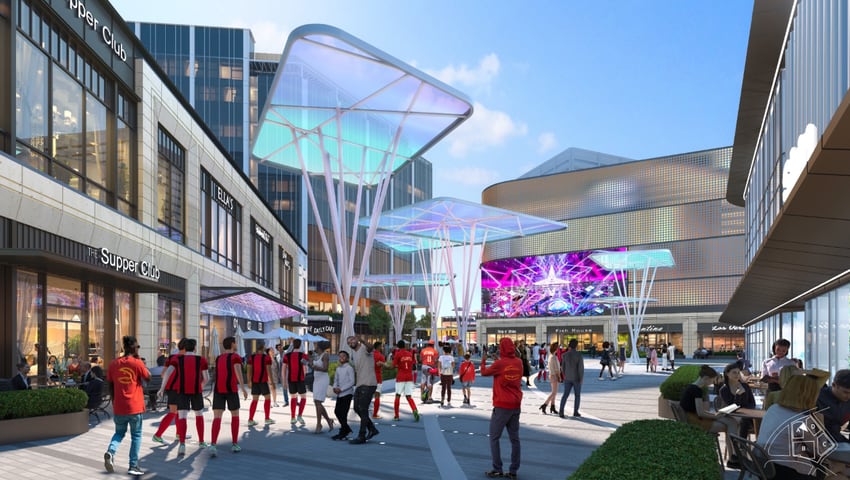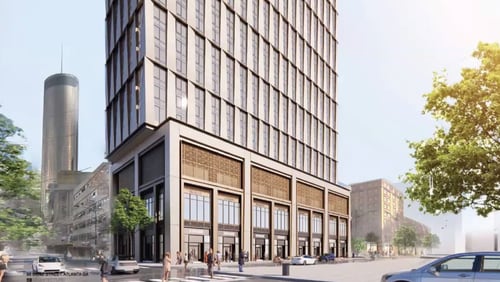The vision for Centennial Yards, the multibillion-dollar project poised to transform downtown Atlanta’s Gulch, is starting to come into finer focus.
Six years after the Atlanta City Council greenlit the project, Centennial Yards’ developer says it will feature more residential and a bigger focus on entertainment and hospitality along with fewer offices than early-stage plans. The updated vision reflects post-pandemic economic realities of persistent remote and hybrid work and companies needing less office space.
But the high-rises that are expected to fill the 50-acre void between Mercedes-Benz Stadium and MARTA’s Five Points station promise to bring thousands of new housing units and new life to streets that are often empty when the workday ends or there aren’t big events at the downtown arenas.
The COVID-19 pandemic changed the development landscape of urban areas like downtown, prompting developer CIM Group to retool Atlanta’s largest project. Centennial Yards CEO Brian McGowan, the CIM executive helming the project, said those market forces pushed his team to prioritize residential, hotel and entertainment aspects until demand rebounds for new office space.
“You’ve got to create the environment where offices want to be,” he said. “You want the residential, the bars and restaurants, the hospitality, the fan zones and the placemaking... That’s the ultimate vision.”
Credit: Miguel Martinez
Credit: Miguel Martinez
Earlier in July, the California-based developer broke ground on the centerpiece of that new vision — an 8-acre entertainment district.
Credit: Courtesy Gensler
Credit: Courtesy Gensler
The nearly 500,000-square-foot phase consists of a 5,000-seat arena, a 14-story hotel, two retail and restaurant buildings and a large gathering plaza. Construction is expected to conclude in 2026 before Atlanta hosts multiple World Cup matches, providing a new space for thousands of sports fans to gather in the shadow of Mercedes-Benz Stadium.
The entertainment district will join a 292-room hotel and a 304-unit apartment building already underway. McGowan said he aims to add at least another 1,000 apartments to those currently delivered or under construction, adding that the entire project could include up to 3,000 units — triple the initial plan from 2018.
Egbert Perry, the CEO of longtime Atlanta developer Integral Group, said the Gulch has long been a dead zone separating downtown and Westside neighborhoods.
“It’s really re-knitting a part of the city that actually needs to be knitted back together,” Perry said. “Their efforts should be applauded. It’s a heavy lift, especially at this time in the marketplace.”
Atlanta leaders in 2018 approved an incentive package of up to $1.9 billion — the largest in city history — to support the project. It requires the developer to build at least 4 million square feet, with a ceiling of 12 million square feet. CIM has decades to deliver their part of the deal and can only access the majority of those incentives upon hitting certain milestones.
McGowan said the most recent site plan envisions 6 million to 7 million square feet upon completion. This includes up to 1.5 million square feet of new offices once demand rebounds.
“We believe office is going to come back,” he said. “It’s not an option for us. We’re going to build office.”
‘Playing long ball’
As originally proposed in 2018, Centennial Yards was envisioned as an office behemoth.
Most of the site — enough floorspace to fill Atlanta’s tallest building seven times — had been planned for offices.
CIM intended to capitalize on Atlanta’s rising profile as a technology and corporate hub, which saw companies like Microsoft and BlackRock flock to Midtown. The Gulch was even pitched as a possible location for Amazon’s second headquarters, known as HQ2. (That project ultimately landed in northern Virginia.)
Midtown long ago supplanted downtown and Buckhead as the city’s top office market.
AJ Robinson, the president of downtown civic group Central Atlanta Progress (CAP), said the last new office building erected in the core of downtown was Allen Plaza in 2007, a building on Ivan Allen Boulevard that immediately faced distress and foreclosure in the wake of the Great Recession.
Corporations slashed office space in the wake of the pandemic, and the lack of demand for new construction only exacerbated challenges for downtown offices at Centennial Yards. Robinson said the developer had to adapt.
“They’re playing long ball here,” he said. “They have enough of a long-term horizon to think about how they’ll mix in office when that market does return.”
New office construction has slowed to a crawl. Less than 1.4 million square feet was under construction as of June, according to real estate services firm CBRE. About one-third of the region’s office space is available for lease, an historically high amount.
McGowan said a 520,000-square-foot office building rising 26 stories is fully designed for Centennial Yards. It would rise on the site of The Atlanta Journal-Constitution’s former downtown printing press building at 72 Marietta St.
The office tower is being marketed, but construction would only start if Centennial Yards lands a large prospect.
“It’s really a matter of sequencing. When you have a big mixed-use project like this that is playing out over a decade, you can switch emphasis,” McGowan said. “If hotels are doing better, you build that now and build the office later.”
All-in on residential
The Gulch, which lies 40 feet below the surrounding viaducts, has been Atlanta’s longtime parking lot.
But downtown has nearly 100,000 parking spaces — too much, CAP’s Robinson argues — and housing would be a better use for that land.
Credit: Miguel Martinez
Credit: Miguel Martinez
Credit: Miguel Martinez/AJC
Credit: Miguel Martinez/AJC
“Anytime you can replace surface parking with density of any type, that’s a good thing,” Robinson said. “You can’t build too much housing in downtown Atlanta.”
Midtown, the Westside and Buckhead had thousands of apartments under construction at the end of April, according to Atlanta-based real estate consulting firm Haddow & Co. Downtown only had 615 units, but the number of proposed apartments in the city center is starting to increase.
Centennial Yards has already delivered or is currently building about 500 units, with more to come. McGowan said a lot of downtown’s challenges, such as its unsafe perceptions, would be alleviated by getting more people on the streets.
“Revitalizing a downtown ... is not rocket science. It’s getting more people living downtown that will solve the problem,” he said. “We don’t need fancy consultants and expensive studies to tell us how to fix it. Just make that happen.”
The city’s incentive package requires Centennial Yards to reserve 20% of all apartments built in the Gulch at below-market rents for 99 years. Julian Bene, a former Invest Atlanta board member who unsuccessfully sued to try to scuttle the incentives, still has his concerns about the project, but said additional affordable housing is a silver lining.
“Adding supply of apartments has to be somewhat beneficial to everyone,” he said. “… I don’t believe in handing over $1.9 billion in tax subsidy for (a few hundred) affordable units, but I’m fine with there being (more) affordable units.”
Money left on tap
CIM went before Invest Atlanta in June for approval to issue roughly $557 million in bonds to support the construction costs of its forthcoming entertainment district, the first time the developer tapped into its bundle of incentives.
Ben Vera, vice president of CIM, said the developer had to tally $400 million in project costs before it could access the bond financing, which will be repaid through future tax revenue streams generated within Centennial Yards. The bonds come from two sources: an “Enterprise Zone” the city created under state law for the Gulch’s redevelopment and the Westside Tax Allocation District. The Enterprise Zone allows the developer to collect 5 cents of the 8.9-cent sales tax on retail sales to repay bond investors.
There’s still a large amount remaining for subsequent development phases. The total EZ bond pool is up to $1.25 billion, while the Westside TAD pool is up to $625 million. To make another request of Invest Atlanta, CIM will have to deliver at least 500,000 square feet of new development and wait at least six months since the last bond draw, Vera said.
“The next hurdle is no longer a dollar investment requirement,” he said. “It’s a delivery hurdle.”
Bene said downtown is a challenging retail market and an unproven residential neighborhood, so CIM could face challenges collecting the tax revenues it needs to pay back the bonds. Bene said many of the entertainment aspects are “somewhat pie-in-the-sky projects” and future parts of Centennial Yards could be just as speculative. The developer disputes both sentiments.
In addition to the entertainment district, CIM is in final negotiations to build a 300,000-square-foot expansion to an existing data center at 56 Marietta St.
McGowan said several retail tenants have shown interest in leasing space within the entertainment district. Currently, a Wild Leap brewery is the project’s only open tenant, operating out of a retail space called the Canyon at the former Southern Railway freight depot and office building, which has been converted into 162 apartments.
Credit: Jason Getz / [email protected]
Within Centennial Yards’ orbit, several other projects are ramping up mixed-use and community-building initiatives. A 10-block section of South Downtown was recently acquired by the founders of Atlanta Ventures, who plan to focus on business incubators and entrepreneurship spaces. A development team was also recently selected to redevelop the 11-acre lawn known as the Home Depot Backyard into an entertainment complex.
Perry, the Integral Group CEO who is part of a team tasked with converting the 2 Peachtree tower into apartments near the Five Points station, said Centennial Yards has the scale to influence everyone in its wake.
“Drop a boulder in the water and there’s a ripple effect in all directions,” he said. “That’s what will happen here.”
Future of Downtown
This story is part of an occasional series by the AJC to look at the future of Atlanta’s downtown. Several high-profile developments are poised to bring billions of dollars into the city’s core while it continues to grapple with the fallout of the COVID-19 pandemic and a challenging real estate financing market. Downtown will also soon garner international attention when the World Cup comes to Atlanta in 2026, providing a deadline for the city and downtown stakeholders to make promised improvements.
About the Author























